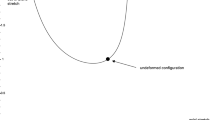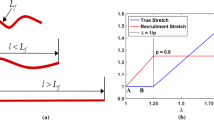Abstract
A plethora of phenomenological and structure-motivated constitutive models have thus far been used as pseudoelastic descriptors in arterial biomechanics, but their parameters have not been explicitly correlated with histology. This study associated biaxial histological data with strain-energy function (SEF) parameters derived from uniaxial tension data of arteries from different topographical sites (carotid artery vs. thoracic aorta vs. femoral artery). A two-term SEF fitted the passive stress–strain data of healthy porcine tissue, justified by the biphasic response characterizing elastin-rich tissues. Selection of a quadratic (orthotropic) over the neo-Hookean (isotropic) term was dictated by the directional dissimilarities in low-stress mechanical response, consistent with our histological data indicating orthotropic symmetry for unstressed elastin. Use of the exponential term was dictated by mechanical dissimilarities at high stresses and variations in unstressed collagen composition and orientation. Accurate fits were attained; topographical variations and anisotropy in material parameters were accounted by respective variations in histomorphometrical data.






Similar content being viewed by others
References
Carboni M, Desch GW, Weizsäcker HW (2007) Passive mechanical properties of porcine left circumflex artery and its mathematical description. Med Eng Phys 29:8–16
Chew PH, Yin FCP, Zeger SL (1986) Biaxial stress-strain properties of canine pericardium. J Mol Cell Cardiol 18:567–578
Cox RH (1978) Passive mechanics and connective tissue composition of canine arteries. Am J Physiol 234:H533–H541
Crissman RS (1986) SEM observations of the elastic networks in canine femoral artery. Am J Anat 175:481–492
Demiray H, Weizsäcker HW, Pascale K (1986) A mechanical model for passive behaviour of rats carotid artery. Biomed Tech 31:46–52
Dobrin PB, Canfield T (1984) Elastase, collagenase, and the biaxial elastic properties of dog carotid artery. Am J Physiol 237:H124–H131
Finlay HM, McCullough L, Canham PB (1995) Three-dimensional collagen organization of human brain arteries at different transmural pressures. J Vasc Res 32:301–312
Fronek K, Fung YC (1980) Mechanical properties of arteries as a function of topography and age. Biorheology 17:227–234
Gabella G (1995) Complex structure of the common carotid artery of sheep. Anat Rec 243:376–383
Gasser CT, Ogden RW, Holzapfel GA (2006) Hyperelastic modelling of arterial layers with distributed collagen fibre orientations. J R Soc Interface 3:15–35
Groenink M, Langerak SE, Vanbavel E et al (1999) The influence of aging and aortic stiffness on permanent dilation and breaking stress of the thoracic descending aorta. Cardiovasc Res 43:471–480
Haas KS, Phillips SJ, Comerota AJ et al (1991) The architecture of adventitial elastin in the canine infrarenal aorta. Anat Rec 230:86–96
Hayashi K (1994) Experimental approaches on measuring the mechanical properties and constitutive laws of arterial walls. J Biomech Eng 115:481–488
Holzapfel GA (2006) Determination of material models for arterial walls from uniaxial extension tests and histological structure. J Theor Biol 238:290–302
Holzapfel GA, Weizsäcker HW (1998) Biomechanical behavior of the arterial wall and its numerical characterization. Comput Biol Med 28:377–392
Holzapfel GA, Gasser CT, Ogden RW (2000) A new constitutive framework for arterial wall mechanics and a comparative study of material models. J Elasticity 61:1–48
Holzapfel GA, Sommer G, Gasser CT et al (2005) Determination of layer-specific mechanical properties of human coronary arteries with nonatherosclerotic intimal thickening and related constitutive modeling. Am J Physiol-Heart Circ Physiol 289:H2048–H2058
Humphrey JD (1995) Mechanics of the arterial wall: review and directions. Crit Rev Biomed Eng 23:1–162
Humphrey JD (2002) Cardiovascular solid mechanics: cells, tissues, and organs. Springer-Verlag, New York
Humphrey JD, Vawter DL, Vito RP (1987) Pseudoelasticity of excised visceral pleura. J Biomech Eng 109:115–120
Iliopoulos DC, Kritharis EP, Giagini AT et al (2009) Ascending thoracic aortic aneurysms are associated with compositional remodeling and vessel stiffening but not weakening in age-matched subjects. J Thorac Cardiovasc Surg 137:101–109
Kang T, Humphrey JD, Yin FCP (1996) Comparison of biaxial mechanical properties of excised endocardium and epicardium. Am J Physiol-Heart Circ Physiol 39:H2169–H2176
Langewouters GJ, Wesseling KH, Goedhard WJ (1984) The static elastic properties of 45 human thoracic and 20 abdominal aortas in vitro and the parameters of a new model. J Biomech 17:425–435
Pascale K, Weizsäcker HW, Gauster A et al (1982) The rheological properties of the arterial wall. Rheol Acta 21:607–610
Pianosi C, Burattini AR, Desch GW et al (1999) Biphasic stress-strain relationship of arteries: dependence on topography and animal species. Proceedings of the 1st European medical and biological engineering conference EMBEC’99, Vienna, Austria. Med Biol Eng Comput 37:1432–1433
Rezakhaniha R, Stergiopulos N (2008) A structural model of the venous wall considering elastin anisotropy. J Biomech Eng 130:031017
Rhodin JAG (1980) Architecture of the vessel wall. In: Bohr DF, Somlyo AD, Sparks HV Jr (eds) Handbook of physiology, section 2: the cardiovascular system. Volume II: vascular smooth muscle. American Physiological Society, Bethesda, MD, pp 1–31
Roach MR (1983) The pattern of elastin in the aorta and large arteries of mammals. In: Nugent J, O’Connor M (eds) Development of the vascular system. Ciba Found. Symp. 100. Pitman, London, pp 36–55
Roach MR, Burton AC (1957) The reason for the shape of the distensibility curves of arteries. Can J Biochem 35:681–690
Roach MR, Song SH (1988) Arterial elastin as seen with scanning electron microscopy: a review. Scan Microsc 2:994–1004
Schulze-Bauer CAJ, Morth C, Holzapfel GA (2003) Passive biaxial mechanical response of aged human iliac arteries. J Biomech Eng 125:395–406
Sherebrin MH, Song SH, Roach MR (1982) Mechanical anisotropy of purified elastin from the thoracic aorta of dog and sheep. Can J Biochem Physiol 61:539–545
Snowhill PB, Silver FH (2005) A mechanical model of porcine vascular tissues-part II: stress-strain and mechanical properties of juvenile porcine blood vessels. Cardiovasc Eng 5:157–169
Sokolis DP (2007) Three-part passive constitutive laws for the aorta in simple elongation. J Med Eng Technol 35:1213–1223
Sokolis DP (2007) Passive mechanical properties and structure of the aorta: segmental analysis. Acta Physiol (Oxf) 190:277–289
Sokolis DP (2008) Passive mechanical properties and constitutive modeling of blood vessels in relation to microstructure. Med Biol Eng Comput 46:1187–1199
Sokolis DP, Kefaloyannis EM, Kouloukoussa M et al (2006) A structural basis for the aortic stress-strain relation in uniaxial tension. J Biomech 39:1651–1662
Timmins LH, Evagora CA, Moore JE Jr et al (2008) Experimental investigation of mechanical and structural inhomogeneity in bovine carotid arteries. In: Proceedings of the ASME 2008 summer bioengineering conference (SBC2008), Marco Island, FL, USA, pp 1–2
Tong P, Fung YC (1976) The stress-strain relationship for skin. J Biomech 9:649–657
VanBavel E, Siersma P, Spaan JAE (2003) Elasticity of passive blood vessels: a new concept. Am J Physiol Heart Circ Physiol 285:H1986–H2000
Vito RP, Dixon SA (2003) Blood vessel constitutive models—1995–2002. Ann Rev Biomed Eng 5:413–439
Wolinsky H, Glagov S (1964) Structural basis for the static mechanical properties of the aortic media. Circ Res 14:400–413
Yamada H (1970) Strength of biological materials. Williams & Wilkins, Baltimore
Zhou J, Fung YC (1996) The degree of nonlinearity and anisotropy of blood vessel elasticity. Proc Natl Acad Sci USA 94:14255–14260
Zulliger MA, Fridez P, Hayashi K et al (2004) A strain energy function for arteries accounting for wall composition and structure. J Biomech 37:989–1000
Author information
Authors and Affiliations
Corresponding author
Rights and permissions
About this article
Cite this article
Sokolis, D.P. A passive strain-energy function for elastic and muscular arteries: correlation of material parameters with histological data. Med Biol Eng Comput 48, 507–518 (2010). https://doi.org/10.1007/s11517-010-0598-x
Received:
Accepted:
Published:
Issue Date:
DOI: https://doi.org/10.1007/s11517-010-0598-x




